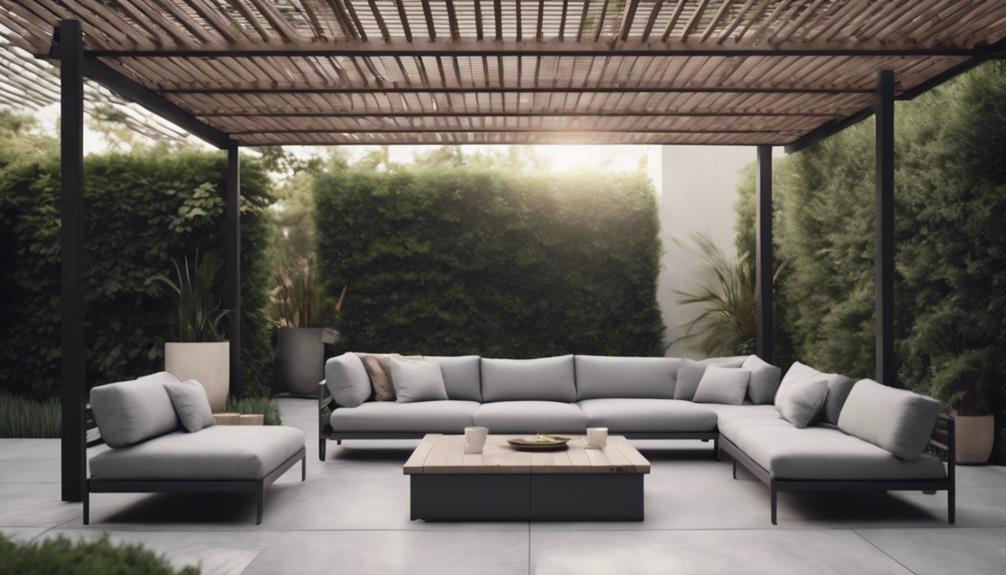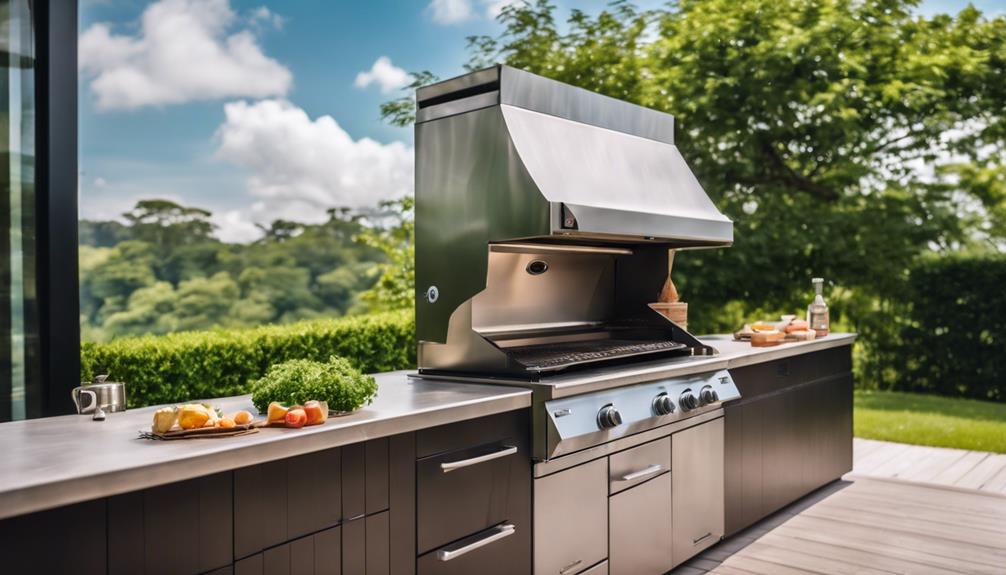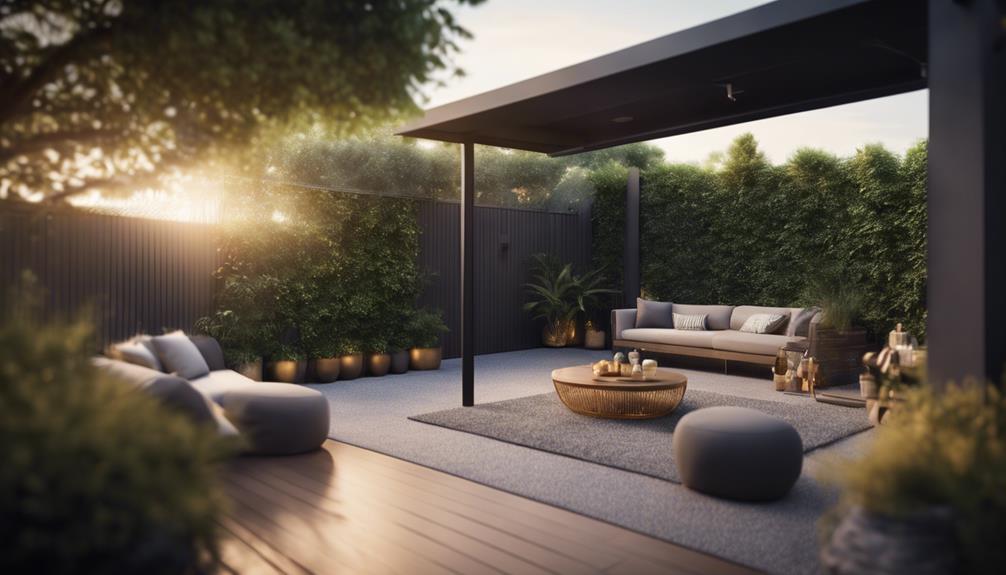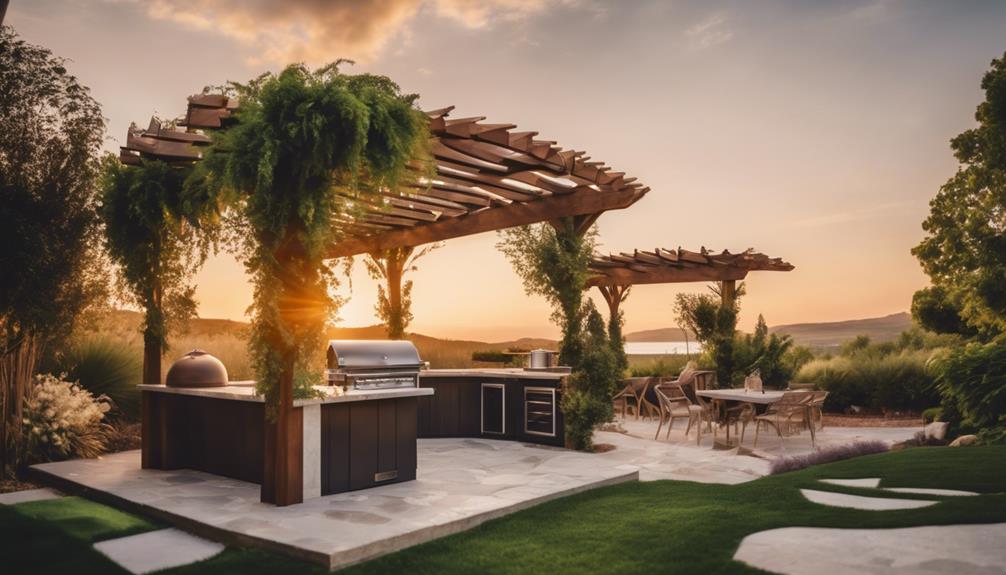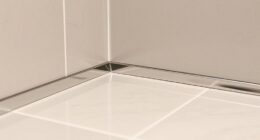When creating the perfect alfresco area, you want outdoor tiles that can withstand harsh weather and elevate your space with style. Unglazed ceramic and porcelain tiles are great options, offering durability and resistance to outdoor elements. Consider tiles with slip ratings of R10 or higher for safety. You can choose from various finishes, like timber, stone, or concrete looks. With minimal maintenance, alfresco tiles enhance your outdoor living area, creating an ambiance perfect for relaxing or entertaining. Want to learn more about finding the perfect tiles for your outdoor oasis?
Key Takeaways
- For alfresco areas, choose tiles with high slip ratings (R10 or higher) to ensure safety and durability in outdoor conditions.
- Porcelain tiles are ideal for harsh weather due to their water-resistance and durability, while ceramic tiles offer various colors and styles.
- Regular cleaning and sealing of outdoor tiles prevent dirt buildup and water damage, ensuring low maintenance and longevity.
- Align tile colors and styles with the surrounding landscape and architecture to create a harmonious design that enhances the alfresco area's ambiance.
- Consider timber, stone, concrete, or plain tile finishes to create a unique and stylish outdoor space that reflects personal style and complements the surrounding environment.
Types of Outdoor Tiles
When selecting outdoor tiles, you'll find a wide range of options, each with its unique characteristics, benefits, and suitability for alfresco spaces. You might be wondering, what're the best types of outdoor tiles for your project? Let's explore!
Unglazed ceramic tiles, for instance, are a fantastic choice due to their durability and resistance to outdoor elements. If you're looking for something even more water-resistant, porcelain tiles are the way to go. They don't absorb water, making them perfect for outdoor use. With porcelain, you can rest assured your tiles will withstand the elements.
When choosing your outdoor tile, make sure to check the slip ratings – you'll want a rating of R10 or higher for safety reasons. And don't forget to consider the finishes available, such as timber, stone, concrete, or plain tile ranges, which can add a unique touch to your outdoor space.
With so many options, you're bound to find the perfect tile to suit your alfresco style.
Benefits of Alfresco Tiles
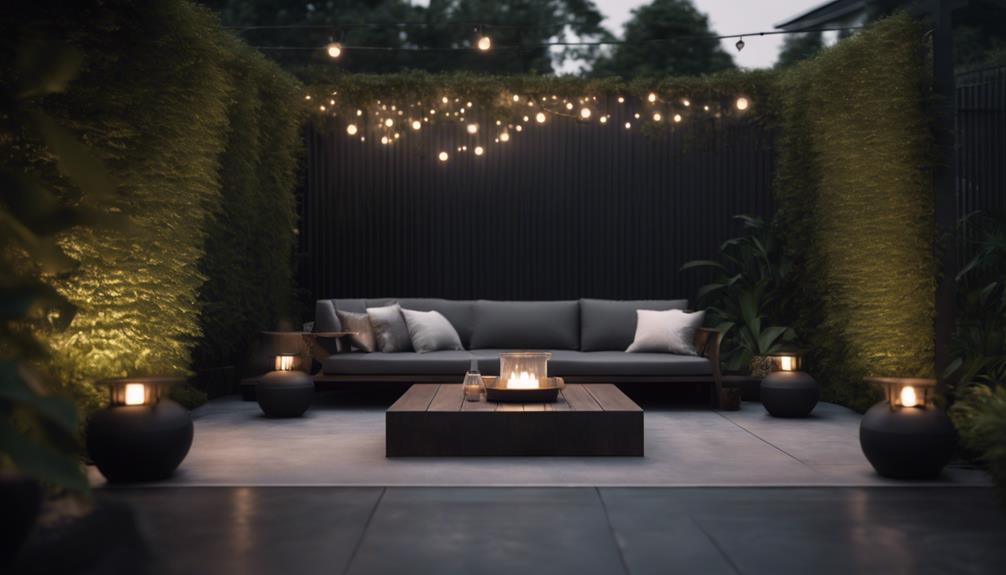
Now that you've got the perfect alfresco tiles, it's time to enjoy the benefits!
You'll love how they can withstand the harsh outdoor weather conditions, and how they create an ambiance that's perfect for relaxing or entertaining.
With alfresco tiles, you'll be able to make the most of your outdoor space, and that's just the beginning!
Weather Resistance Matters
You anticipate your alfresco tiles to withstand the harsh outdoor elements, and rightly so, since they'll be constantly exposed to rain, scorching sun, and temperature fluctuations.
After all, you want your outdoor space to remain beautiful and functional, not damaged or worn out prematurely. To guarantee this, it's crucial to select outdoor tiles that are weather-resistant, durable, and can handle high traffic.
You don't want your alfresco tiles to absorb water, which can lead to damage or discoloration. Opt for tiles with low water-absorption rates to prevent such issues.
Additionally, slip-resistant tiles are a must, especially in areas prone to wet conditions, to ensure safety and prevent accidents.
Finally, your alfresco tiles should complement the overall design of your outdoor space, offering both practicality and style.
Enhanced Outdoor Ambiance
By incorporating alfresco tiles into your outdoor space, you can effortlessly enhance the ambiance, creating a seamless connection between indoor and outdoor living areas. With alfresco tiles, you can achieve a smooth shift between your indoor and outdoor spaces, making your home feel more spacious and connected. These tiles bring a level of sophistication to your outdoor area, making it perfect for relaxation, entertainment, or even a quiet evening with family and friends.
The best part? Alfresco tiles require minimal maintenance, so you can focus on enjoying your outdoor space rather than worrying about upkeep. Plus, they're weather-resistant, so you don't have to stress about stains, slips, or harsh weather conditions damaging your tiles.
With a wide range of styles, colors, and finishes to choose from, you can easily find the perfect tile to complement your outdoor space. By choosing alfresco tiles, you'll not only enhance your outdoor ambiance but also add durability and style to your outdoor area.
Choosing the Right Material
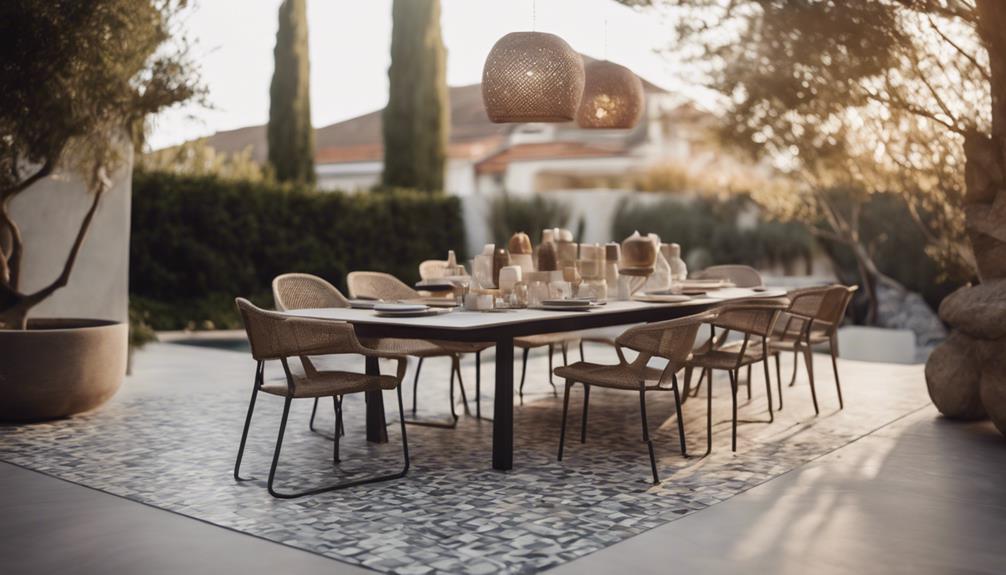
When selecting outdoor tiles for your alfresco area, it's important to weigh the pros and cons of each material, as the right choice can greatly impact the overall aesthetic and functionality of your outdoor space.
Let's break down the popular options:
| Material | Durability | Style |
|---|---|---|
| Porcelain Tiles | High | Modern, Versatile |
| Ceramic Tiles | Medium | Colorful, Stylish |
| Natural Stone | High | Luxurious, Elegant |
| Concrete Countertops | High | Modern, Industrial |
As you can see, each material has its strengths and weaknesses. Porcelain tiles are a popular choice for outdoor spaces due to their durability and water resistance, making them perfect for harsh weather conditions. Ceramic tiles, on the other hand, offer a variety of colors and styles but may require more maintenance. Natural stone tiles provide a luxurious look, while concrete countertops offer a modern and affordable alternative. By considering your needs and preferences, you can choose the perfect material for your outdoor tiles and create an alfresco area that's both beautiful and functional.
Durability and Maintenance
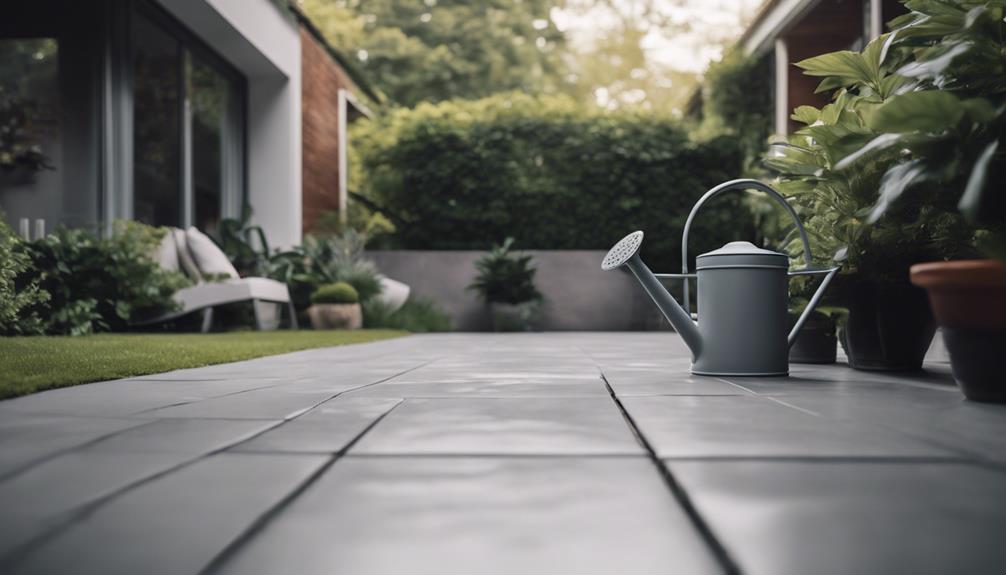
Five key factors contribute to the durability and maintenance of outdoor tiles, ensuring your alfresco area remains functional and beautiful for years to come.
You want to make sure your outdoor tiles can withstand the varying weather conditions, from scorching sun to heavy rainfall. The good news is that outdoor tiles are low-maintenance, making them perfect for alfresco areas.
High-quality outdoor tiles are resistant to stains, scratches, and fading, so you don't have to worry about their appearance deteriorating over time. Regular cleaning and sealing can also help prevent dirt buildup, mold growth, and water damage in your alfresco space.
By choosing outdoor tiles with high durability and easy maintenance, you'll enhance the overall appeal and usability of your alfresco area. With proper installation and maintenance, you can reduce the need for frequent repairs and enjoy your outdoor space for years to come.
Design and Aesthetic Options
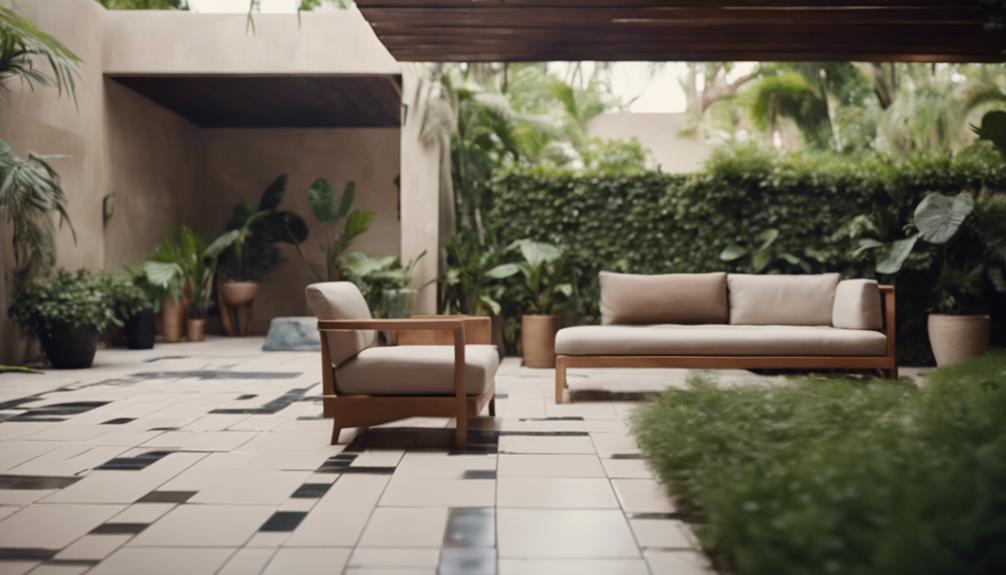
Having confirmed that your outdoor tiles can withstand the elements, now it's time to focus on making a stylish statement with your alfresco area's design and aesthetic.
When selecting patio tiles, consider aligning the colors and styles with the surrounding landscape and architecture for a harmonious design. You can even add a touch of elegance with marble tile or create a unique mosaic tile design that reflects your personal style.
To take your outdoor space to the next level, consider incorporating water features or custom mosaic murals that serve as eye-catching statements tailored to your theme. Remember to take into account natural light levels and architectural coherence when choosing outdoor tiles for a seamless look.
You can also mimic natural elements like wood or stone with your tile selection, adding visual appeal and blending well with the outdoor environment. By selecting quality tiles that enhance the overall aesthetic of your outdoor area, you'll achieve a design that's both stylish and functional.
Outdoor Tile Installation Tips
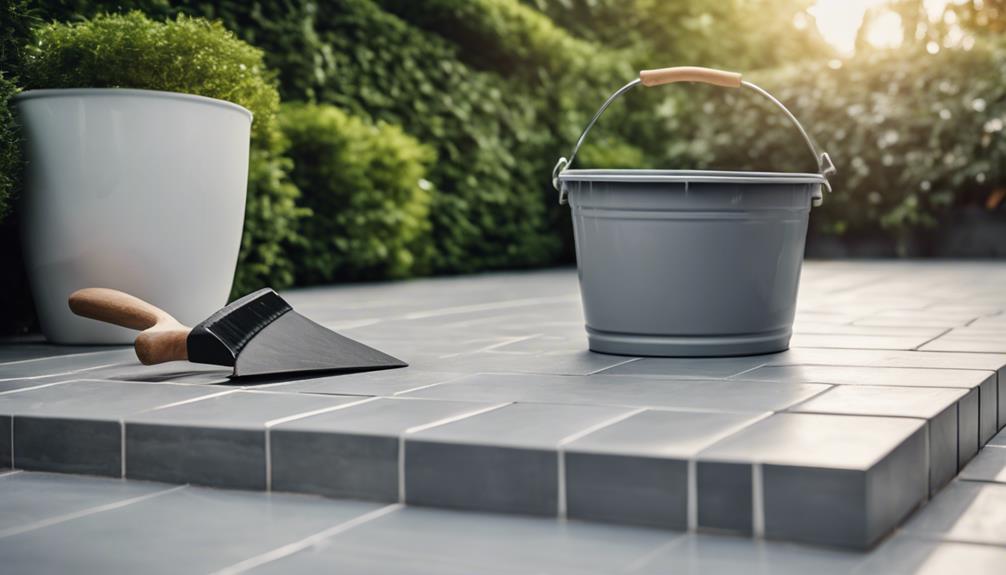
You'll need to think about the basics right from the start, as proper subfloor preparation lays the foundation for a successful outdoor tile installation. This means ensuring your subfloor is level, clean, and dry before applying those gorgeous tiles.
Next, choose quality adhesives and grouts specifically designed for outdoor use, as they'll withstand harsh weather conditions and temperature changes. Don't forget to take into account the climate in your area and plan for expansion joints to accommodate those temperature fluctuations. This will prevent your tiles from buckling or breaking.
After installation, remember to maintain your outdoor space with regular cleaning and sealing to keep those tiles looking their best. By following these tips, you'll enjoy a beautiful and durable outdoor space for years to come.
Comparing Tiles to Pavers
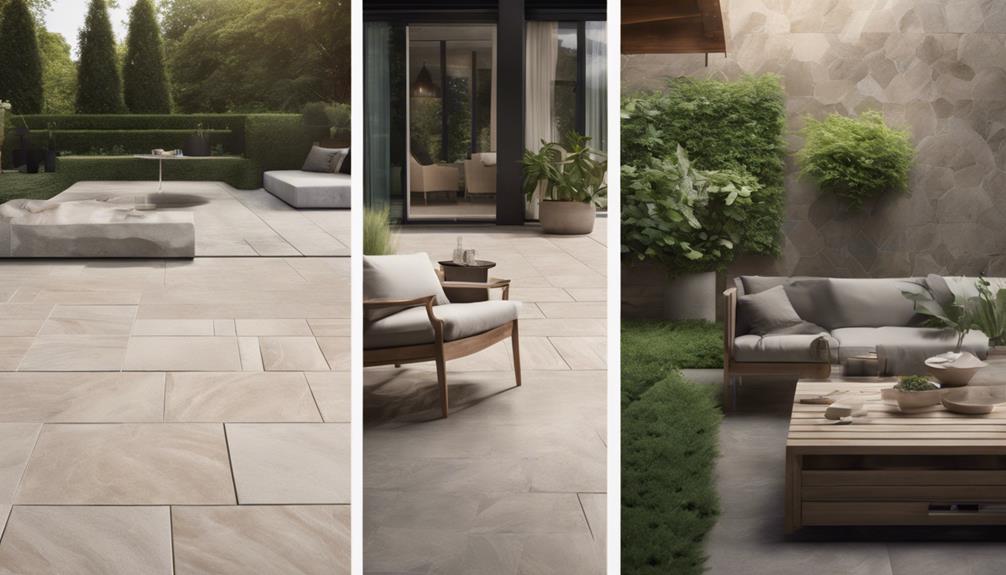
Now that you've got the basics of outdoor tile installation down, it's time to weigh your options and consider what's best for your alfresco space.
As you explore the world of outdoor flooring, you'll likely find yourself comparing tiles to pavers – and for good reason!
Let's take a closer look at how these two popular options stack up when it comes to material strength and aesthetic versatility.
Material Strength Comparison
Comparing tiles to pavers for your alfresco area reveals that while pavers boast a rugged, natural look, tiles offer a more polished appearance and superior durability.
When it comes to outdoor use, tiles are the clear winner. They're secured by adhesives and grouting, making them incredibly durable and suitable for heavy foot traffic. Plus, they're stain-resistant, so you don't have to worry about spills or messes leaving permanent marks.
And let's not forget about maintenance – tiles require minimal upkeep, unlike pavers which can be a real pain to clean. On top of that, outdoor tiles are often more affordable than pavers, offering a cost-effective option for your alfresco area.
And did I mention customization? With tiles, you can create a unique look that reflects your personal style. So, if you're looking for a practical and stylish solution for your outdoor space, tiles are the way to go!
Aesthetic Versatility Showdown
When designing your alfresco area, the aesthetic versatility of tiles and pavers is an important aspect to take into account, as it can make or break the overall ambiance of your outdoor space. You want your patio to seamlessly merge with your indoor living space, creating a cohesive design scheme.
Tiles offer a refined appearance and customization options, making them a great choice for outdoor kitchen design. Porcelain tiles, in particular, are a durable option, with low water absorption rates, making them resistant to water and weather fluctuations.
On the other hand, pavers provide a natural, stone-like look and are a better long-term investment compared to poured concrete slabs. They're also easier to repair if damaged.
Ultimately, the choice between tiles and pavers comes down to your personal style and preferences. If you want a more refined, modern look, tiles might be the way to go. But if you prefer a more natural, rustic aesthetic, pavers could be the perfect fit for your outdoor living space.
Common Outdoor Tile Mistakes
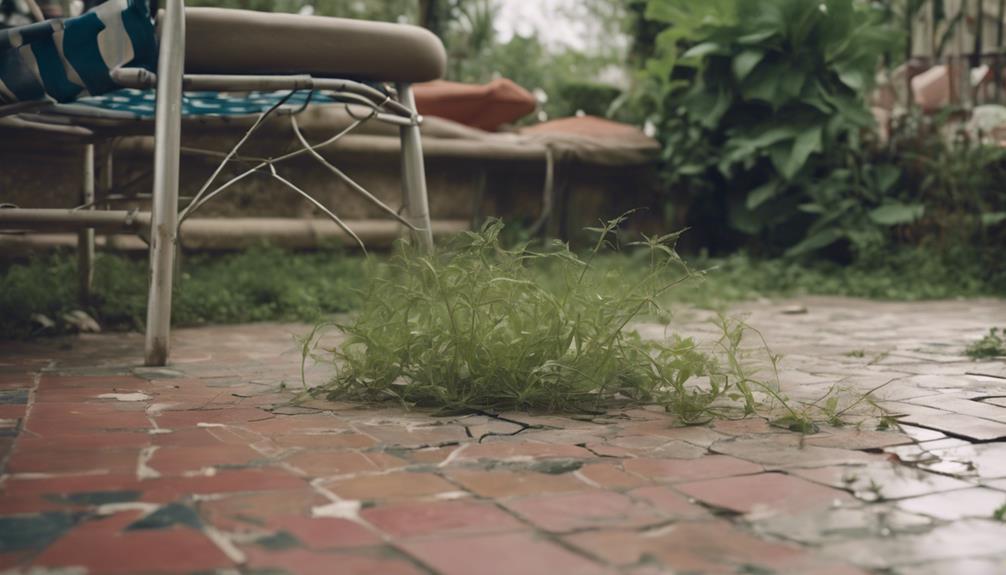
By venturing into the world of outdoor tiling without proper research, you're likely to fall prey to common mistakes that can lead to costly and time-consuming repercussions. One of the most critical mistakes is using indoor tiles outdoors, which can lead to cracking and water damage due to lack of durability and weather resistance. You might think you're saving money, but trust us, it's not worth the hassle.
Another mistake is neglecting to choose slip-resistant outdoor tiles, especially in areas prone to wet conditions. Imagine having friends over for a backyard BBQ, only to have someone slip and fall because you didn't prioritize safety. Not to mention, overlooking proper installation techniques can cause tiles to shift or break over time, impacting durability.
Lastly, failing to seal outdoor tiles regularly can lead to staining, discoloration, and reduced longevity in outdoor environments. And let's not forget about climate considerations – not choosing tiles suitable for your specific outdoor space can affect durability and style.
Don't let these common outdoor tile mistakes ruin your alfresco dreams!
Popular Alfresco Tile Designs
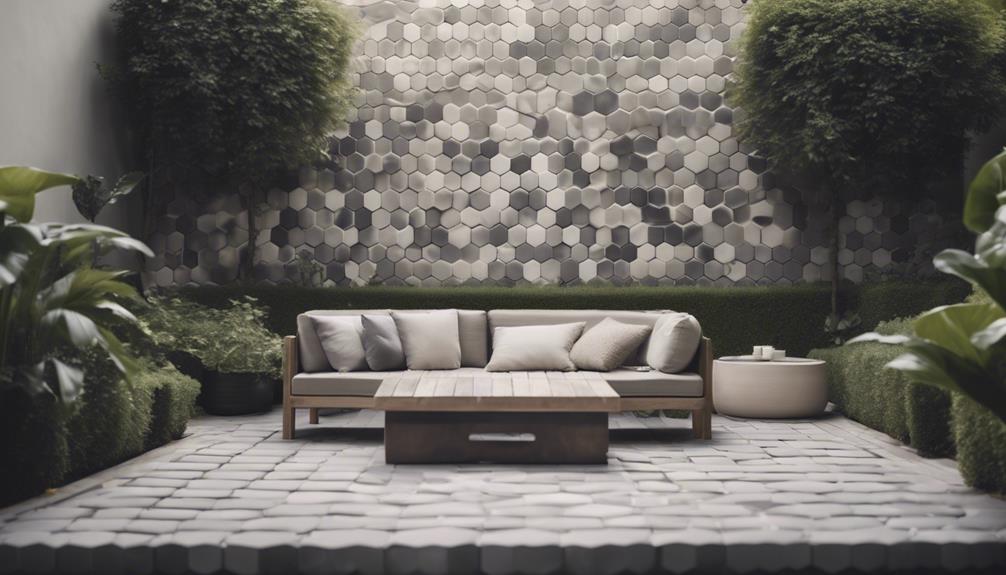
From rustic timber-look tiles to modern concrete-look designs, you'll find a wide range of stylish and functional alfresco tile designs that can elevate your outdoor space. When selecting the perfect tile, take into account the style you want to achieve and how it will blend with the landscape and architectural features of your alfresco area.
Here are three popular alfresco tile designs worth exploring:
- Timber-look tiles: Ideal for creating a cozy and natural ambiance, timber-look tiles are a great option for alfresco areas surrounded by greenery.
- Stone-look tiles: Infuse a touch of sophistication with stone-look tiles that replicate the elegance of natural stone.
- Concrete-look tiles: For a modern and industrial vibe, concrete-look tiles are a great choice, particularly when paired with sleek outdoor furniture.
Frequently Asked Questions
What Is the Best Type of Tile for Outdoor Use?
You're wondering what's the best type of tile for outdoor use, right? Well, let me tell you – porcelain tiles are the way to go!
They're super durable, resistant to water, and require minimal maintenance. Plus, they're perfect for areas exposed to moisture, thanks to their low water-absorption rate.
You can't go wrong with porcelain tiles for your outdoor space!
What Type of Tile Is the Most Durable?
So, you're wondering what type of tile is the most durable? Well, let's cut to the chase – porcelain tiles take the cake!
They're super dense, water-resistant, and have a low water absorption rate, making them perfect for outdoor areas.
Plus, they're resistant to stains, scratches, and harsh weather conditions.
With proper installation and maintenance, these tiles will look great for years to come!
What Is the Best Tile to Use for an Outdoor Kitchen?
When it comes to choosing the best tile for your outdoor kitchen, you've got a few options to take into account.
But, if you want the most durable and low-maintenance choice, porcelain tiles are the way to go!
They can withstand harsh weather conditions, are easy to clean, and can even handle high temperatures.
Plus, they come in a range of styles and colors to fit your outdoor kitchen's vibe.
What Is the Best Protection for Outdoor Tiles?
So, you're wondering what's the best protection for your outdoor tiles? Well, let me tell you – it's all about sealants!
Applying a high-quality sealant regularly can make a huge difference. It creates a protective barrier against stains, water damage, and harsh UV rays. Trust me, your tiles will thank you!
With a good sealant, you'll notice they're easier to clean, less prone to damage, and will last way longer.
Conclusion
So, you've made it to the end of our outdoor tile adventure! Now, go forth and tile that alfresco space like a pro!
Did you know that, according to the National Association of Home Builders, 70% of homeowners consider outdoor living spaces, like alfresco areas, essential for their dream home?
With the right tiles, you can create a stunning outdoor oasis that'll make you the envy of the neighborhood!
